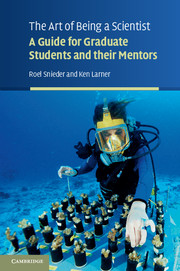Book contents
- Frontmatter
- Contents
- 1 Introduction
- 2 What is science?
- 3 Choices, choices, choices
- 4 The adviser and thesis committee
- 5 Questions drive research
- 6 Giving direction to our work
- 7 Turning challenges into opportunities
- 8 Ethics of research
- 9 Using the scientific literature
- 10 Communication
- 11 Publishing a paper
- 12 Time management
- 13 Writing proposals
- 14 The scientific career
- 15 Applying for a job
- 16 Concluding remarks
- Appendix A Further reading
- Appendix B A sample curriculum
- Appendix C The Refer and BibTeX format
- References
- About the authors
- Index
Appendix B - A sample curriculum
Published online by Cambridge University Press: 05 June 2014
- Frontmatter
- Contents
- 1 Introduction
- 2 What is science?
- 3 Choices, choices, choices
- 4 The adviser and thesis committee
- 5 Questions drive research
- 6 Giving direction to our work
- 7 Turning challenges into opportunities
- 8 Ethics of research
- 9 Using the scientific literature
- 10 Communication
- 11 Publishing a paper
- 12 Time management
- 13 Writing proposals
- 14 The scientific career
- 15 Applying for a job
- 16 Concluding remarks
- Appendix A Further reading
- Appendix B A sample curriculum
- Appendix C The Refer and BibTeX format
- References
- About the authors
- Index
Summary
The material presented in this book lends itself well for a course for beginning graduate students. Such students are under time pressure when starting their research and taking courses in their chosen discipline. For this reason our best experience has been in teaching the course as a single-semester, 1-credit course, which amounts to approximately 15 classroom sessions. This appendix gives a sample curriculum aimed at offering instructors ideas for elements that could be included in such a course. The curriculum includes homework assignments that roughly follow the chapters in this book, but doing all assignments is unnecessary and might make the workload unacceptably high. The suggested homework is intended to inspire instructors' ideas for helpful exercises.
Our experience is that it is best to teach the course to classes no larger than about 20 students. The material is conveyed most effectively in a discussion format rather than as a lecture that offers relatively little opportunity for student participation. Some topics covered are likely to touch on personal issues; many students find it easier to pose questions and share personal views and dilemmas in a small group.
Class 1. What the course and science are about. Since the course is most effective when there is ample discussion, it is important that students feel comfortable in the group. It is helpful for students to have the opportunity to introduce themselves in class and mention, for example, what they hope to learn in this course and any personal issues or questions they would like to share.
- Type
- Chapter
- Information
- The Art of Being a ScientistA Guide for Graduate Students and their Mentors, pp. 265 - 272Publisher: Cambridge University PressPrint publication year: 2009

